The real story regarding 1MDB that has never been told

This is part three in the series titled Clare Rewcastle Brown’s ‘heist of the century’. In this third and final part we will reveal how Husni and Muhyiddin knew back in 2013 that 1MDB was going to be sabotaged. However, instead of warning Najib about it, Muhyiddin approached Mahathir to discuss how they could help ensure that the sabotage is successful and use this to bring Najib down and at the same time walk away with a large sum of money.
The Third Force
For the past year or so, the name Aabar Investments PJS Limited has been making headlines the world over, a company registered in the BVI and the reason IPIC had a falling out with 1MDB. Currently, the two factions appear locked in dispute over the status of the company, which officials from IPIC insist isn’t one of theirs.
The Malaysian Ministry of Finance (MoF) found this difficult to believe, considering that the BVI registered entity (Aabar-BVI) had officials from IPIC listed as stakeholders. That, and the fact that the MoF has in its possession agreements negotiated through Qubaisi in his capacity as the chair of an Abu Dhabi entity bearing a name similar to that of the BVI company.
The MoF insists that Aabar-BVI is a subsidiary of IPIC. What the MoF did now know is someone from the ministry conspired to withhold information that had the potential of averting a dispute currently being arbitrated in a London court. And that person is none other than the former Second Minister of Finance, Dato’ Seri Ahmad Husni bin Mohamad Hanadzlah.
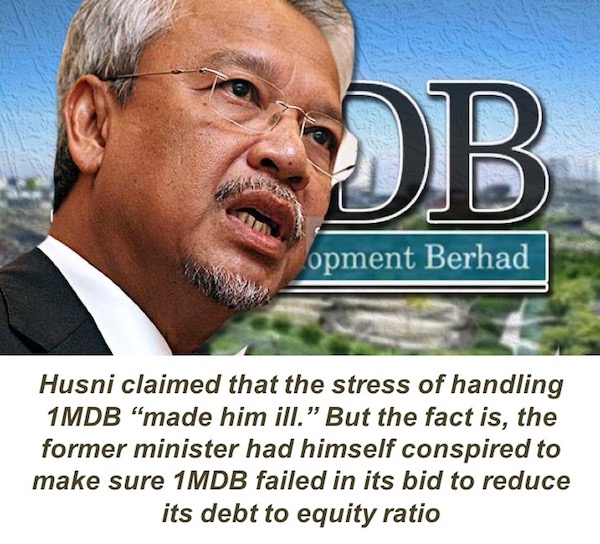
Husni came to know early in 2013 what the CEO of 1MDB, Dato’ Shahrol Azral Ibrahim Halmi, had known since December 2012. The former minister discovered that the BVI registered Aabar was in fact a vehicle through which Qubaisi robbed the Malaysian fund. It was brought to his attention that a mismatch existed in 1MDB’s dealings with IPIC. Yet, Husni deviously chose to remain silent and instead played innocent by questioning the government’s motives for setting up the wealth fund.
Should authorities conduct a thorough background check on Husni, they will discover communications proving the former minister’s knowledge of a scheme to sabotage 1MDB. While my team has yet to complete a discovery on Shahrol, it is clear to us that Husni had known of the scheme since January 2013.
The Chief Editor of Sarawak Report, Clare Rewcastle Brown, implicated Najib in a complicity to rob 1MBD. But there is a lot she kept hidden from us. For instance, she failed to mention the reason she finds it absolutely necessary that Qubaisi and Najib be found guilty of fraud and acts of criminal malfeasance.
And that’s what we’re here to discover. Through this article, the final in a three-part series, we will find out if funds from 1MDB were indeed stolen, and if so, who benefited most from the theft. Most importantly, we will figure out – for the first time ever – how Ms. Rewcastle stands to benefit should the London International Court of Arbitration find 1MDB in default of its obligations to IPIC.
Suspect #1 and 2: Husni and Qubaisi
The first person that will benefit from the spiriting of 1MDB’s money through the BVI is Husni. The second is Qubaisi, who may have accumulated material wealth worth approximately USD600 million, a large portion of which was converted into fixed assets in the US.
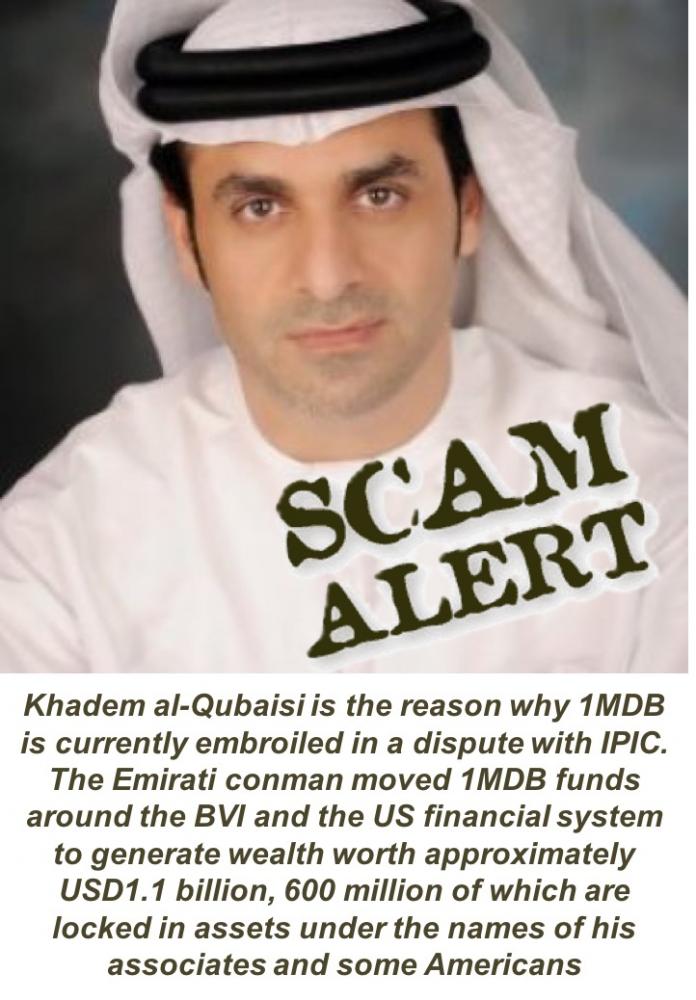
A month after 1MDB sealed a multi-billion-dollar joint-venture agreement with China’s SGCC (refer preceding article), Qubaisi began establishing a network of entities in the BVI that grew in numbers with each passing month. By 2014, there were at least five entities bearing the name Aabar, two of which were struck off on the 1st of May that year pursuant to Section 2013(1)(c) of the BVI Business Companies Act (2004). The companies had defaulted in payment of annual fees and fines imposed for various offences.
A check by my team revealed that these entities – Aabar Resources (Global) Limited (Aabar Global) and Aabar Strategic Investments Limited (Aabar Strategic) – along with several others had facilitated transfers worth billions for IPIC despite them being unrelated to the Abu Dhabi fund. A further check revealed that the money ended up being spirited through the US financial system before being converted into fixed assets.
As we dug deeper, we discovered that a sizable portion of money that was channeled through Qubaisi’s BVI network in 2013 had originated from 1MDB. It appears that a former minister is at this very moment the beneficial owner of a property unit in the US worth approximately USD5 million, purchased using wealth Qubaisi generated by moving that money around the BVI and, thereafter, the US.
This ex-minister is said to have questioned the government on the 24th of October 2016 for its failure “to act on the management of 1MDB for investing money in the wrong places.” The only person who fits the description is Husni, the former Second Minister of Finance, who posed that very question on that very day when debating the 2017 Supply Bill in Parliament. It seems that Husni had been paid to keep his mouth shut.
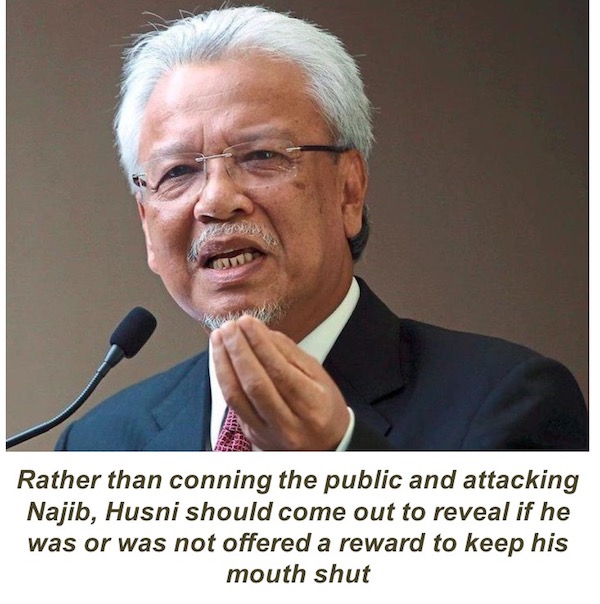
Suspect # 3, 4, 5, 6, and 7: Jürgen Mossack, Soros, Mansour, Marcus and Tony Blair
The man who taught Qubaisi everything there was to know about tax havens and money laundering was Jürgen Mossack. Throughout the year 2013, Mossack helped Qubaisi channel wealth from the BVI through many of Soros’ offshore interests to generate surpluses. Most of that surplus was shared between Mossack, Qubaisi, Mansour and Soros despite that wealth belonging either to the government of Abu Dhabi or to sovereign wealth funds.
Mossack, a tax scam expert, is the son of Erhard Mossack, a Nazi SS officer from a unit once known as the ‘Death’s Head division’. In 1977, Mossack founded a controversial law firm – the Mossack Fonseca & Co – and taught Soros everything there was to know about ways to evade tax authorities. Early in February 2010, Massack began imparting that knowledge to Qubaisi and taught the former IPIC Managing Director ways to con world governments.
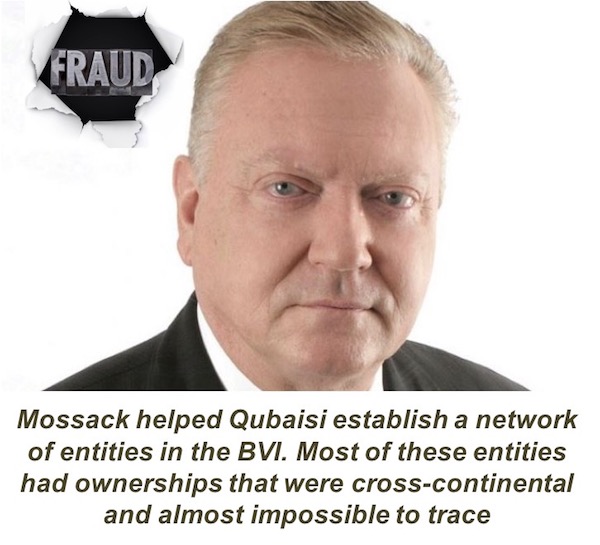
The first thing Mossack told Qubaisi to do was to coax Amanda Staveley into transferring the ownership of PGI3 to Nexus Capital Investing Limited, a BVI concern wholly owned by the Abu Dhabi International United Investments LLC, or ADIUI. To recap, PGI3 was a BVI registered vehicle through which Ms. Staveley secured 758,437,618 shares from Barclays in 2009 (refer preceding article).
ADIUI, in turn, was 100 percent owned by Mansour, meaning, the IPIC chair had gained full control of those shares. Mossack needed the ownership transferred to Mansour as relations between Ms. Staveley and IPIC had gone to pot. As Qubaisi understood it, Mansour was to dispose of those shares and channel proceeds through his BVI network.
However, just as Mansour was about to do that, word got out that Mohammed, Mansour’s brother, was in discussions with certain Abu Dhabi officials on the possibility of establishing partnerships with 1MDB. It is not known if the Malaysian government was in touch with Mohammed at this point. Nonetheless, Mansour made many attempts to dissuade his brother, the Crown Prince of Abu Dhabi, from diving into a deal with the Malaysian government. But Mohammed stood his ground.
As a result, Mansour decided to hold on to his seven-odd percent in Barclays just yet. The thing that Mansour feared most was that his brother would get him to dump proceeds from the sale of those shares into 1MDB, the same way the Crown Prince got him to pledge billions to Barclays in 2008. Mansour went on to caution Blair that his brother was dead serious about forging an alliance with the Malaysian fund.
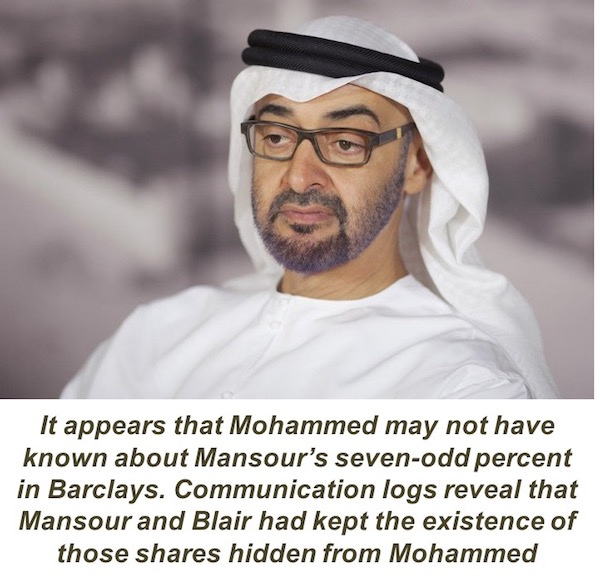
On the 18th of October 2010, Blair’s biggest fear came to life when Mubadala signed two collaborative agreements centered on energy and infrastructural development worth up to USD7 billion with 1MDB through two of its subsidiaries, Mubadala Real Estate & Hospitality (MREH) and Mubadala Industry (MI).
The announcement triggered some back and forth communication between Qubaisi, Mossack and a group of Emirati businessmen linked to Blair and Marcus. The group discussed ways to ‘fracture’ Mohammed’s ties with Malaysia and decided that the best way forward was to reduce 1MDB to insolvency. An interesting point to note is that the group spoke of ways to generate wealth using funds from 1MDB. The Emirati faction conceded to wait for a time that was most opportune to strike.
That opportunity came on the 7th of March 2012 when 1MDB announced plans to acquire Tanjong Energy Holdings Sdn Bhd for USD2.81 billion from the person who controlled it, Tan Sri Ananda Krishnan.
Suspect #8: Unknown official from Ministry of Finance
1MDB’s purchase of Tanjong afforded the Malaysian fund a total net generating capacity of 3,951MW through control of the unit’s eight power plants. Months later, on the 14th of August 2012, 1MDB made public a decision to extend that capacity through the purchase of the Genting Group’s 97.7 percent stake in a power and utility unit, Mastika Lagenda Sdn Bhd.
The USD738.01 purchase gave the Malaysian fund control of Mastika’s 75 percent in power generator Genting Sanyen Power and all of Mastika’s holdings in Mastika Utilities & Services and Mastika Water Management. To raise capital needed for the purchases, 1MDB issued two bonds worth USD1.75 billion each through two of its subsidiaries, 1MDB Energy Limited and 1MDB Energy (Langat) Limited.
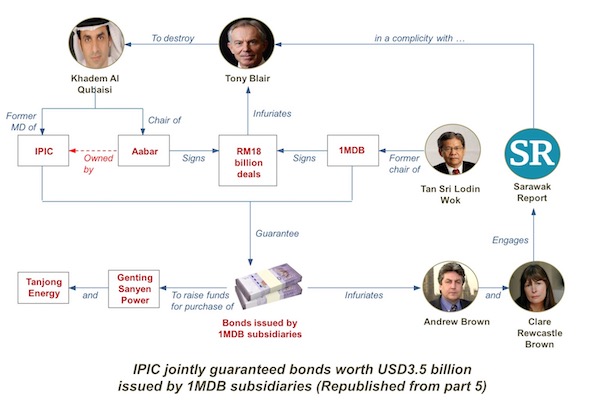
Qubaisi wasted very little time in getting IPIC to guarantee all obligations (principal and associated interests) related to those bonds. But the guarantee came with a very steep price. Under the terms of an agreement sealed between the two funds, 1MDB was to park a security deposit worth USD1.4 billion with IPIC, which Shahrol later authorized to Aabar-BVI.
Shahrol came to know in December 2012 that Qubaisi planned to squeeze 1MDB for cash. He understood why IPIC had made such exorbitant demands, including stock options that gave IPIC and all its subsidiaries the right to acquire up to a 49 percent stake in 1MDB Energy Sdn Bhd, a subsidiary company of the Malaysian fund (since renamed Powertek Investment Holding Sdn Bhd, or PIHSB).
But Shahrol made no mention of this to Najib or the bulk of the fund’s board members. While my team is still in the midst of a discovery into Shahrol’s dealings with the Mideast, it appears that the former CEO of 1MDB may have struck a deal of sorts with Qubaisi some time in December 2012 itself.
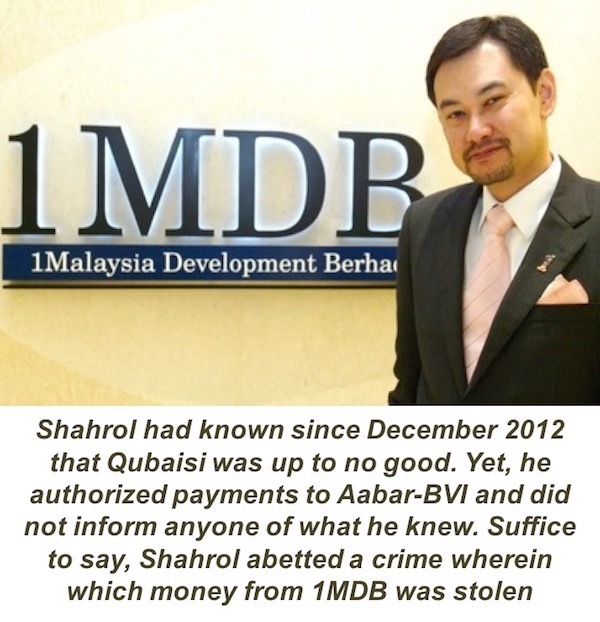
Qubaisi’s interest in PIHSB stemmed from the firm’s 100 percent holding in Krishnan’s Tanjong unit (since renamed Powertek energy Sdn Bhd, or PESB). Months later, Qubaisi came to know of a USD 1.9 billion syndicated bridging loan that 1MDB secured through a consortium of borrowers led by the Malayan Banking Berhad (Maybank).
Now, all this would have been fine if we assume that officials from 1MDB had informed Qubaisi of the bridging loan. However, Qubaisi had in his possession confidential information pertaining transactions 1MDB had performed since 2009, including summary notes of negotiations that took place between the Malaysian fund and Maybank officials in 2012.
So how did he get hold of all that information?
Well, prior to negotiations that took place between 1MDB and IPIC, Blair had already been tipped off by officials from PetroSaudi of dealings that had gone on between the Malaysian fund and the Saudis. The information related to a USD2.5 billion partnership PetroSaudi had entered with 1MDB on the 30th of September 2009. Basically, Blair needed to know if there were people in 1MDB that his team could use.
The former British premier was given access to such information due to a £41,000 a month advisory role he secretly negotiated with PetroSaudi back in November 2010. Apart from the two percent commission that came with every deal he helped broker with the Chinese, Blair was promised access to confidential information that pertained the Saudi firm and its dealings with foreign wealth funds.
But that is not all. Blair found himself in a unique position owing to another advisory position he held. On the 1st of January 2008, Blair was made the advisor of JPMorgan Chase & Co (JP), the largest financial institution in the US by net asset worth. Blair negotiated the role through Jamie Dimon, the bank’s chairman and CEO, who offered the former British premier an annual salary of £2 million without the need for him to enter office.
Through an executive linked to Michael Cavanagh, Dimon’s deputy, Blair was fed top secret information that pertained 1MDB and its dealings with PetroSaudi. As if that wasn’t peculiar enough, the same executive seemed to be in possession of details pertaining the USD1.9 billion syndicated bridging loan that 1MDB secured in 2012 to part finance the purchase of Krishnan’s power holdings. Those details were handed over to Blair in April 2013.
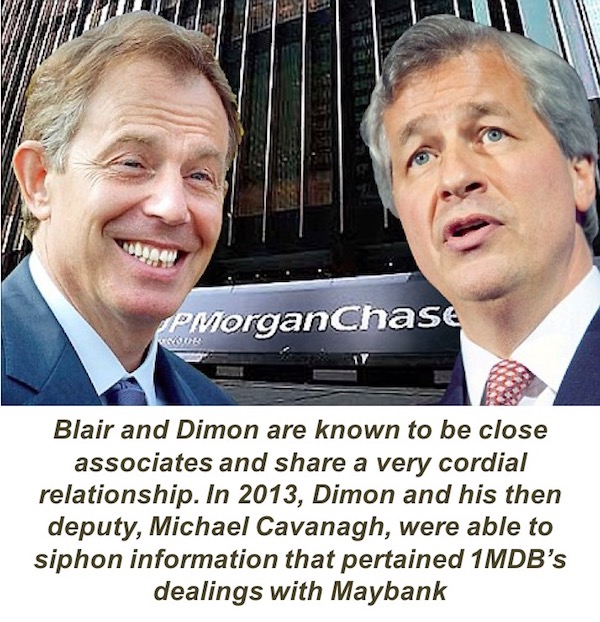
Upon investigation, my team traced the leak of information to an individual subordinate to the current CEO of the Maybank Kim Eng Group (MKEG), Dato’ John Chong. Back in March 2013 when the leak took place, the 13th Malaysian general election was slated to be around the corner. Chong was yet the CEO of Maybank Investment Bank Berhad and was a year away from becoming MKEG’s acting head.
The Maybank official fed Cavanagh’s associate everything that needed to be known about the syndicated loan and a lot more. Blair went on to channel that information to Qubaisi, who in turn, passed it over to a group of Emirati businessmen. With the wealth of information, Qubaisi was able to plan his moves very carefully, knowing well in advance that 1MDB was positioned precariously and would crumble if it defaulted any of its loans.
It appears that the Maybank official was receiving instructions from someone in the Ministry of Finance. Judging from the information leak, it seems that a group of Malaysian bankers were already involved in a conspiracy to sabotage 1MDB even before Tun Dr Mahathir Mohamad got involved.
And yes, there was talk of a ‘reward’ in the event 1MDB was reduced to insolvency.
Suspect #9: Tan Sri Muhyiddin Yassin
In July 2013 or some time thereabouts, the Maybank official commenced a series of communications with another official from Bank Negara, possibly the same person Raja Petra Kamarudin (RPK) referred to in his 13th of August 2016 posting in Malaysia Today (refer link below). These officials, who went by various pseudonyms, received instructions from someone who appeared to be a top executive in CIMB who was specific with instructions to prevent 1MDB from “reducing its debt to equity ratio”.
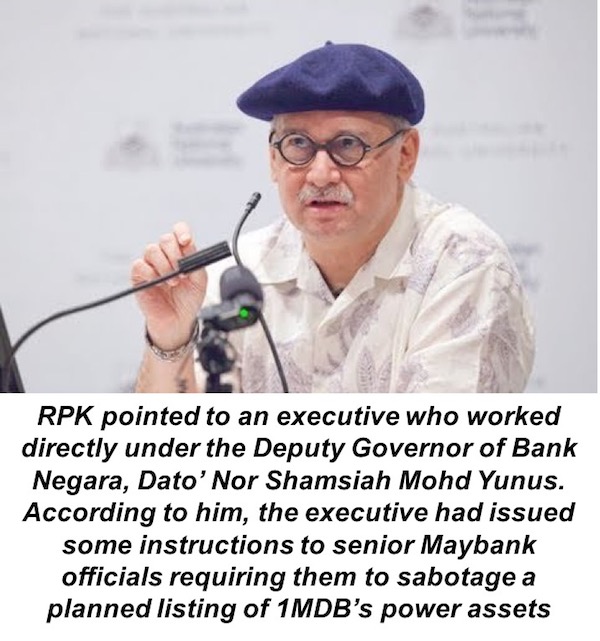
A month later, a series of multi-channeled communications commenced between officials from Bank Negara, Maybank, CIMB, AmBank, Bank Muamalat, the Attorney-General’s Chambers and the Securities Commission, all of whom went by very peculiar pseudonyms and spoke in very peculiar terms. The back and forth related to plans by Tan Sri Muhyiddin Yassin to deprive 1MDB of oxygen and to depict the fund’s Board of Directors as being fraudsters who helped Najib siphon money belonging to Malaysians.
Prior to the back and forth between these officials, Muhyiddin became the first Malaysian politician to be approached by a representative from Blair’s camp, who met the then deputy premier’s aide in June 2013 and told him that an international conspiracy to sabotage 1MDB had begun. The representative gave Muhyiddin’s aide a peek into “evidence of 1MDB’s precarious position” that Blair’s camp had obtained from PetroSaudi, JP and Maybank.
The representative, who seemed to know that Mahathir had planned to wage a vendetta against Najib, told the aide that the clock was ticking, that both Soros and Blair were willing to help destroy Najib if Mahathir or his people reciprocated with top secret information from Bank Negara and the Malaysian Securities Commission.
A very excited Muhyiddin immediately approached Mahathir and conveyed with optimism that 1MDB was about to be sabotaged. Mahathir liked what he heard and gave Muhyiddin the go-ahead to assemble a team to assist Blair and Soros. Secretly, though, the former premier decided to wait and see what Blair and Soros had in mind before making his move.
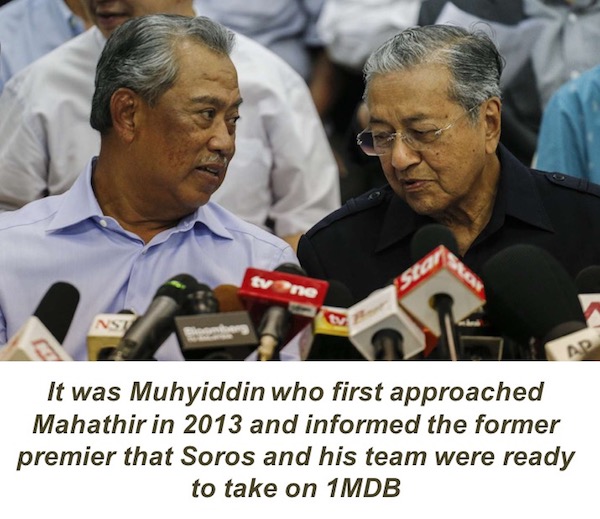
But unbeknown to Mahathir, Muhyiddin was offered a cut amounting some USD30 million in the event the former deputy premier could convince the Malaysian authorities that Najib was responsible for dissipating billions from 1MDB into thin air. The broad idea was for Muhyiddin to keep the spotlight pointed away from Qubaisi and his team while they worked to bankrupt the Malaysian fund.
That explains why the former deputy premier still sticks around Mahathir despite knowing that he has a cat in hell’s chance of becoming the next Prime Minister of Malaysia. To leverage his position, Muhyiddin roped Tony Pua into the conspiracy by telling the DAP parliamentarian that 1MDB was about to be sabotaged by a group of foreigners.
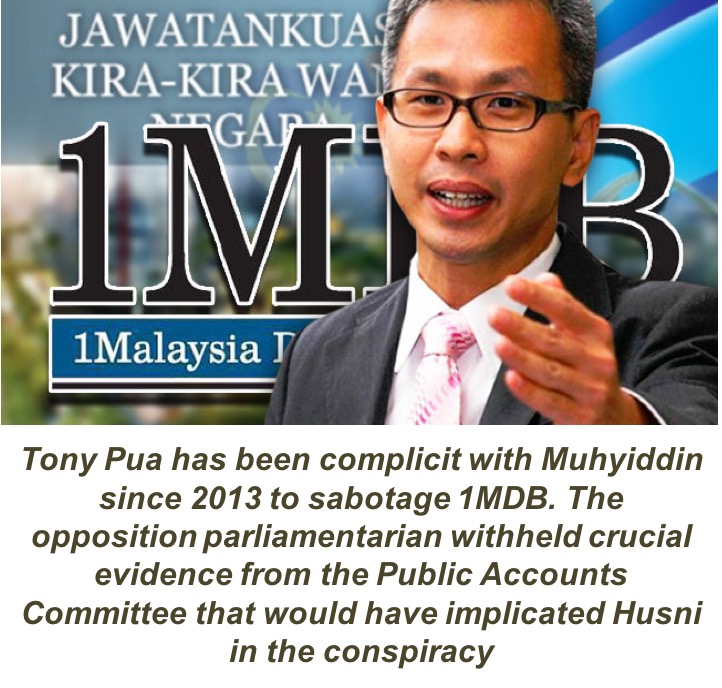
Suspect #10: Clare Rewcastle Brown
Not many are aware that 1MDB first decided to list its power assets in 2012, days after the fund purchased Genting’s Mastika units. On the 17th of August 2012, someone with knowledge of the matter confirmed that the fund had planned to raise as much as USD2 billion in an Initial Public Offering (IPO) to help lessen its debt load.
The plan was for the IPO to be made before the 13th general election. Instead, 1MDB issued bonds worth USD3 billion which Goldman Sachs then underwrote and sold at prices above the preset minimum. Word of the bond deal was communicated to Blair by a man named Jackson Eisenpresser, who fed the former British premier the A-Z pertaining the deal. Late in 2013, Eisenpresser told Blair that the IPO had been deferred to a date yet to be fixed by Najib and his men.
In RPK’s 13th of August 2016 posting, he spoke of a conspiracy by Mahathir and his team to sabotage the IPO (refer link below). According to the blogger, persons linked to Mahathir and a former Malaysian Minister of Finance, Tun Daim Zainuddin, approached senior members of 1MDB’s management to act as moles within 1MDB with the sated aim of sabotaging the impending IPO.
While my team concurs that RPK made absolute sense, a similar conspiracy had already been contrived by members of Blair’s team in March 2014. Per plans, Mansour was to have come out on the 15th of August 2014 to announce that 1MDB had yet to fulfill part of its obligations to IPIC pursuant to agreements that existed between the two funds.
A coincidence?
Our investigations revealed that Mansour had planned to publically dissociate IPIC from Aabar-BVI by ‘pointing out’ to Najib that 1MDB officials had made a grave error in judgment. The date for the announcement was deemed appropriate by Mansour and Qubaisi to afford the latter time to divest his holdings and that of his associates in all his BVI concerns. Qubaisi was in the midst of negotiating the sale of some assets in the US, including one or two units the US Department of Justice spoke of in its 20th of July 2016 press conference.
But something unexpected happened.
Qubaisi became upset that Mansour was taking so long to remit some payments due to him. The payments related to Mansour’s seven-odd percent in Barclays (refer preceding article) that Qubaisi once held a beneficial interest in. On the 19th of July 2013, Mansour shocked everyone when he disposed of those shares, the existence of which was not known even to his advisors.
Following the sale, a misunderstanding erupted between Mansour and Qubaisi. The latter demanded a slice of profits since it was he who once held those shares in trust for Mansour. After some back and forth, Mansour agreed to channel ten percent of the profits to Qubaisi. But the ten percent never came.
On the 30th of July 2014, Qubaisi drew the line. He told Mansour that he had no intention of returning IPIC’s interests – worth some USD20 billion in various asset categories – that Qubaisi and his associates were the beneficial owners of. A very shaken Mansour immediately got in touch with an associate of his and related what had just happened.
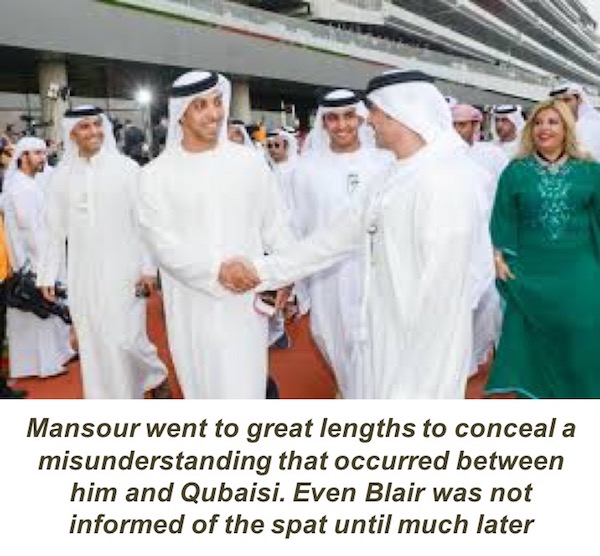
When the associate heard what he heard, all hell broke loose. He insisted that Qubaisi be relieved of his positions in IPIC. But Mansour was reluctant to do so as both he and Qubaisi had jointly participated in the issue of some instruments. On the 10th of August 2014, a decision was reached – Mansour would delay the planned 15th of August 2014 announcement while he sorted things out.
By then, Clare Rewcastle Brown had already been approached by persons from Blair’s camp to participate in a conspiracy to sabotage 1MDB (refer details in parts four, five and six). Owing to developments in Abu Dhabi, Ms. Rewcastle was told to put the spotlight on Jho Low while they figured out what to do with Qubaisi. On the 28th of February 2015, Ms. Rewcastle published Heist of the Century and zeroed in on Jho’s alleged relationship with Najib and his family.
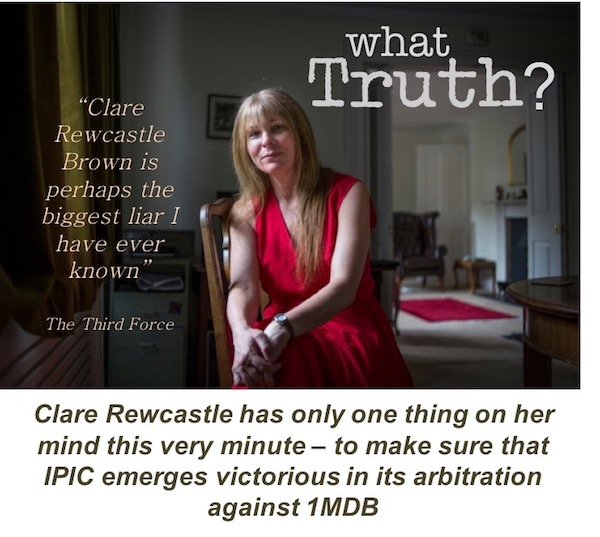
When a July 2015 coup attempt against Najib fell flat on its face, plans changed. Ms. Rewcastle was told to shift the spotlight on Qubaisi by accusing the former IPIC Managing Director of conspiring with 1MDB officials to rob wealth that belonged to the people of Malaysia. She did just that through a 26th of September 2015 article titled King Khadem and his sovereign wealth.
According to my sources, the Sarawak Report Chief Editor was promised a multi-million dollar reward in the event 1MDB loses its case in the London Court of International Arbitration. The case revolves around the status of the BVI registered Aabar which 1MDB insists was a subsidiary of IPIC.
If 1MDB loses the case, the fund would officially be in default of its obligations pursuant to agreements it entered with IPIC. In all likelihood, 1MDB would have to remit a yet-to-be-determined sum of money to the Abu Dhabi fund, which is sure to range in the billions.
Unbeknown to the Malaysian government, the arbitration was Blair’s idea and a way of killing two birds with one stone – to get paid a commission from Mansour commensurate to the portion of money Qubaisi owed him and to saddle the Malaysian fund with more debt.
As for Mansour, a victory would pave the way for him to trigger action pursuant to law against Qubaisi, on grounds that the former IPIC Managing Director had used the same modus operandi to siphon wealth from the Abu Dhabi fund.
And Ms. Rewcastle?
Well, a verdict against 1MDB would help her ‘prove’ that Najib had known all along the BVI registered Aabar was a bogus entity. Or so she would claim, raising suspicion among Malaysians that Najib had conspired with Qubaisi to rob the fund of its wealth. In Malaysia, what matters most is the ink of perception, which Ms. Rewcastle knows all too well is most difficult to erase.
And it is that ink that will earn her more millions through Dr. Mahathir Mohammad.
To be continued…
PAST ARTICLES IN THIS SERIES
Part 1: http://www.malaysia-today.net/how-anwar-helped-soros-cripple-the-asian-economy/
Part 3: http://www.malaysia-today.net/mahathir-mukhriz-soros-and-the-khazarian-conspiracy/
Part 4: http://www.malaysia-today.net/the-blair-rewcastle-multifaceted-complicity-to-destroy-1mdb/
My Reply to Rewcastle: http://www.malaysia-today.net/my-reply-to-clare-rewcastles-half-past-six-rebuttal/
Part 6: http://www.malaysia-today.net/when-the-rewcastles-and-the-sentinels-squirm-like-dying-worms/
Part 7: http://www.malaysia-today.net/clare-rewcastle-brown-withheld-evidence-from-british-authorities/
Part 8: http://www.malaysia-today.net/mahathir-muhyiddin-goldman-sacs-and-1mdb/
Part 9: http://www.malaysia-today.net/clare-rewcastle-browns-heist-of-the-century-retold-1-of-3/
Part 10: http://www.malaysia-today.net/clare-rewcastle-browns-heist-of-the-century-retold-2-of-3/

